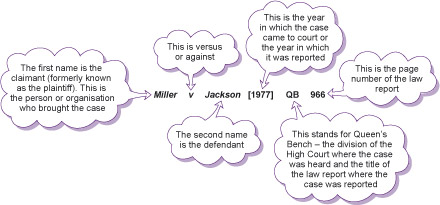Legal cases
Where there appears to be a conflict between the rights of two (or more) people or organisations this may result in a dispute that is settled in court. One such dispute occurred in the village of Lintz in County Durham and culminated in the famous legal case of Miller v Jackson [1977] QB 966.
Before we go on to look at this case, it is a good idea to have a quick look at the format of case names and the way in which legal cases are presented (see Figure 1). In a civil case, a judge (or judges) will hear the information presented by both sides of the dispute. The person bringing the dispute is known as the claimant (in older cases the term plaintiff was used); the person defending it is known as the defendant. Once the judge or judges have listened to all the facts and the evidence, they will make a decision. This decision is known as their judgment and is made by applying the law to the facts of the case (please note, the usual spelling is ‘judgement’, however, when referring to a decision of the court it is spelled ‘judgment’, without the middle ‘e’).
The case we are going to look at concerned a dispute between Mr and Mrs Miller and a local cricket club about the number of cricket balls that were hit out of the cricket ground, landing on the Millers’ property, damaging their house and risking personal injury to Mr and Mrs Miller. Mr and Mrs Miller were the plaintiffs and Mr Jackson, the chairman of the cricket club, on behalf of its members, was the defendant. Cricket had been played at the cricket ground in Lintz since the early 1900s. In the 1970s, a field next to the cricket ground was sold to a developer who built a number of houses there. Mr and Mrs Miller bought one of the houses. Their house and garden were only 30 metres from where cricket was played. Inevitably, given the proximity of their house and garden to the cricket ground, balls regularly landed on their property. Mr and Mrs Miller approached the cricket club about this and in 1975 the club erected a high fence and told its batsmen to avoid hitting balls over the boundary or fence. Although these measures helped, cricket balls still landed on the Millers’ property and the Millers decided to go to court to sue for damages and to obtain an injunction to prevent cricket being played on the ground. The court therefore had to balance the right of the cricket club to continue to use a ground which it had been playing on for many years before the houses were built, with the right of Mr and Mrs Miller to enjoy their house and garden without fear of being hit by cricket balls themselves or of damage to their house and garden. The case was first heard in the High Court in Nottingham, where the judge agreed to grant the injunction and ordered the cricket club to pay damages. However, the cricket club appealed this decision and Mr and Mrs Miller cross-appealed for more damages. The appeal was heard in the Court of Appeal in 1977 in front of three Court of Appeal judges. One of the judges, Lord Justice Cumming-Bruce, set out what the court had to do. It had to:
seek to strike a fair balance between the rights of the plaintiffs to have quiet enjoyment of their house and garden without exposure to cricket balls occasionally falling like thunderbolts from the heavens and the opportunity of the inhabitants of the village in which they live to continue to enjoy the manly sport which constitutes a summer recreation for adults and young persons.
The Court of Appeal decided that the cricket club should be allowed to continue to play at the ground and so the injunction was not appropriate. However, the sum of damages to be paid by the club to Mr and Mrs Miller was increased to account for past and future damage.
In practice, it is not always easy to achieve the balance between rights and responsibilities, or to achieve a balance that satisfies the rights of different people when, as in Miller v Jackson [1977] QB 966 there is a conflict of rights.

